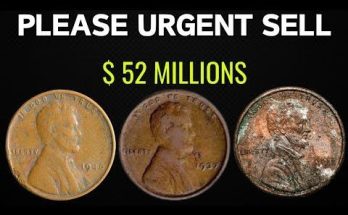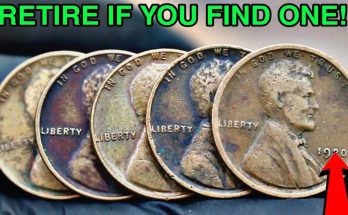A Guide to the 1987 U.S. One-Cent Coin
The 1987 U.S. One-Cent coin, a part of the Lincoln Memorial Cent series (1959-2008), is a fascinating piece of modern American numismatics. While a common coin in everyday circulation, certain varieties and minting errors can transform this unassuming penny into a valuable collector’s item. Understanding its history, key details, and potential rarities is crucial for anyone interested in its value.
The Context: The Lincoln Memorial Cent Series
The Lincoln Memorial Cent was introduced in 1959 to honor the 150th anniversary of Abraham Lincoln’s birth. This design, created by Frank Gasparro, replaced the original “Wheat Ears” reverse, featuring an elegant depiction of the Lincoln Memorial on the back of the coin. The obverse (front) maintained the classic Lincoln portrait by Victor David Brenner.
By 1987, the U.S. Mint had made a significant change to the coin’s composition. In 1982, due to rising copper prices, the penny’s material was shifted from a mostly copper alloy to a copper-plated zinc core. This change is a key detail for collectors, as the zinc core can sometimes lead to unique errors, such as plating bubbles or issues with the copper coating.
Minting Details and Mintage Figures
In 1987, Lincoln Cents were produced at three U.S. Mints, each with a distinct mint mark.
- Philadelphia (No Mint Mark): The Philadelphia Mint produced a massive number of cents in 1987—over 4.6 billion. As was the standard practice for business strikes at the time, these coins bear no mint mark. Due to this high mintage, a regular 1987 Philadelphia cent is not considered rare and is typically worth only its face value of one cent in circulated condition.
- Denver (D Mint Mark): The Denver Mint also contributed to the high mintage of 1987 pennies, producing nearly 4.9 billion coins. Like their Philadelphia counterparts, these coins are common and have a low value unless they possess a specific error or are in a high, uncirculated grade.
- San Francisco (S Mint Mark): The San Francisco Mint did not produce any business strike 1987 pennies for circulation. Instead, it exclusively minted proof coins, which were sold directly to collectors in special sets. These coins are known for their exceptional strike quality and mirrored fields. While more valuable than their business-strike counterparts, they are still relatively common within the proof coin market.
The Hunt for Rare Finds and Errors
The real excitement for collectors lies in finding a 1987 penny with a minting error. These anomalies, which occurred during the production process, can dramatically increase a coin’s value. Some of the most notable and sought-after errors on 1987 cents include:
- Doubled Die Errors (DDO/DDR): This occurs when a coin is struck with a die that has a doubled impression, causing the lettering, date, or other design elements to appear as if they have been slightly blurred or shadowed. A prominent “Doubled Die Obverse” (DDO) can be a significant find.
- Off-Center Strikes: When the coin blank (planchet) is not properly centered on the striking die, the resulting coin can have a large portion of its design missing, creating an off-center look. The more off-center the strike, the more valuable the coin tends to be.
- Broadstrikes: This error happens when the coin is struck without the collar die in place. The resulting coin is wider and thinner than normal, with a flattened rim.
- Die Breaks and Cuds: As minting dies wear out, they can develop cracks. These cracks appear as raised lines on the struck coin. A “cud” is a large piece of the die that has broken off, resulting in a blank, featureless area on the coin’s edge.
While the odds of finding a valuable error coin are low, the sheer volume of 1987 pennies in circulation makes it a popular date for “coin roll hunting.” Many collectors enjoy the thrill of sifting through rolls of cents in the hope of discovering a hidden treasure.
How to Determine Value
The value of a 1987 penny depends on its condition (grade) and whether it has a valuable error. A standard, circulated coin is worth its face value. An uncirculated coin, especially one with a “full red” designation from a grading service like PCGS or NGC, can be worth a few dollars. However, a significant error coin, such as a strong doubled die or a major off-center strike, can sell for hundreds or even thousands of dollars.
In conclusion, the 1987 Lincoln Memorial Cent is a perfect example of how a seemingly common coin can hold hidden value. While most are worth just one cent, the potential for rare finds and unique minting errors makes the series a rewarding and affordable area of focus for collectors of all experience levels.



